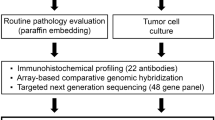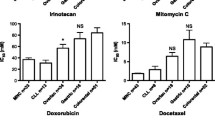Summary
Four permanent clones of a human adenocarcinoma of the stomach and the parent line from which they were isolated were used as an in vitro model system to evaluate the effects of 8 anticancer agents on cell survival. The drugs tested were actinomycin D (Act-D), Bleomycin (Bleo), adriamycin (adria), melphalan, chlorambucil, 5 Fluorouracil (5FU), 1,2:5,6-Dianhydrogalactitol (DAG), and 1-(2-chloroethyl)-3-(4-methyl cyclohexyl-1-nitrosurea) (MeCCNU). Although the cell lines had similar growth properties, morphologies and modal chromosome numbers, the clones expressed heterogeneous survival responses to each of six drugs tested. A comparison of the doses lethal to 90% of a clonal population (LD90) for each drug indicated large differences between the most sensitive and least sensitive clones. For chlorambucil there was a 160% difference between the LD90 values of the most and least sensitive clones. For MeCCNU the difference was 200%; for adria, 230%; Bleo, 280%; 5FU, 360%; and melphalan, 600%. Despite the heterogeneity in response among the clones to these agents, no particular clone was always the most sensitive or resistant.
Of particular interest was the finding that these stomach cancer clones demonstrated uniform responses to both Act-D and DAG. Since the differential drug sensitivities expressed by heterogeneous tumor populations could be a cause of treatment failure in the patient, the demonstration of uniform sensitivities to Act-D and DAG are encouraging and suggest that other anticancer drugs which produce uniform cell killing may be identified and tested.
Act-D and adria were the most effective of the drugs tested when compared on a dose for dose basis. Both agents killed more than 99.9% of the parent cell line with doses below 3μg/ml (1-h treatments). The cells were least sensitive to 5FU, with only 30% of the cells killed at 100 μg/ml.
The studies reported here indicate that this human stomach cancer model can provide valuable insight into the design of clinical protocols for treatment of gastric carcinoma in man.
Similar content being viewed by others
References
Cancer Patient Survival, Report #5, DHEW Publication # (NIH) 77991
Cancer Statistics, CA 31:20–21, 1981
Moertel CG, Reitemeier RJ: Advance Gastrointestinal Cancer: Clinical Management and Chemotherapy. Harper and Row, New York, 1969, pp. 3–14
Nicolson GL, Brunson KW, Fidler U: Specificity of arrest, survival and growth of selected metastatic variant cell lines. Cancer Res 38:4105–4111, 1978
Post G, Doll J, Hart IR, Fidler IJ: In vitro selection of murine B16 melanoma variants with enhanced tissue-invasive properties. Cancer Res 40:1626–1633, 1980
Barranco SC, Drewinko B, Humphrey RM: Differential response by human melanoma cells to 1,3-Bis (2-chloroethyl)-1-nitrosourea and bleomycin. Mutat Res 19:277–280, 1973
Barranco SC, Haenelt BR, Gee EL: Differential sensitivities of five rat hepatoma cell lines to anticancer drugs. Cancer Res 38:656–660, 1978
Barranco SC, Ho DHW, Drewinko B, Romsdahl MM, Humphrey RM: Differential sensitivities of human melanoma cells grown in vitro to arabinosylcytosine. Cancer Res 32:2733–2736, 1972
Biedler JL, Riehm H, Peterson RHF, Spengler BA: Membrane-mediated drug resistance and phenotypic reversion to normal growth behavior of Chinese hamster ovary cells. J Natl Cancer Inst 55:671–680, 1975
Hakansson L, Tropé C: On the presence within tumours of clones that differ in sensitivity to cytostatic drugs. Acta Path Microbiol Scand Sect A 82:35–40, 1974
Heppner GH, Dexter DL, DeNucci T, Miller FR, Calabresi P: Heterogeneity in drug sensitivity among tumor cell subpopulations of a single mammary tumor. Cancer Res 38:3758–3763, 1978
Mørk SJ, Laerum OD: Modal DNA content of human intracranial neoplasms studied by flow cytometry. J Neurosurg 53:198–204, 1980
Romsdahl MM, Hsu TC: Establishment and biological properties of human malignant melanoma cell lines grown in vitro. Surg Forum 18:78–79, 1967
Barranco SC, May JT, Boerwinkle W, Nichols S, Hokanson KM, Schumann J, Göhde W, Bryant J, Guseman LF: Enhanced cell killing through the use of cell kinetics-directed treatment schedules for two drug combinations in vitro. Cancer Res 42:2894–2898, 1982
Barranco SC, Romsdahl MM, Humphrey RM: The radiation response of human malignant melanoma cells grown in vitro. Cancer Res 31:830–833, 1971
Barranco SC, Townsend CM, Costanzi JJ, May JT, Baltz R, O'Quinn AG, Leipzig B, Kohanson KM, Guseman LF, Boerwinkle WR: The use of 1,2:5,6-dianhydrogalactitol in studies on cell kinetics-directed chemotherapy schedules in human tumors in vivo. Cancer Res 42:2899–2905, 1982
Drewinko B, Romsdahl MM, Yang LY, Ahearn MJ, Trujillo JM: Establishment of a human carcinoembryonic antigen-producing colon adenocarcinoma cell line. Cancer Res 36:467–475, 1976
Petersen SE, Bichel P, Lorentzen M: Flow-cytometric demonstration of tumour-cell subpopulations with different DNA content in human colorectal carcinoma. Eur J Cancer 15:383–386, 1978
Schiffer LM, Markoe AM, Nelson JSR: Estimation of tumor growth fraction in murine tumors by the primer-available DNA-dependent DNA polymerase assay. Cancer Res 36:2415–2418, 1976
Shapiro JR, Yung W-KA, Shapiro WR: Isolation, karyotype, and clonal growth of heterogeneous subpopulations of human malignant gliomas. Cancer Res 41:2349–2359, 1981
Tveit KM, Fodstad O, Phil A: The usefulness of human tumor cell lines in the study of chemosensitivity. A study of malignant melanomas. Int J Cancer 28:403–408, 1981
Barranco SC, Townsend Jr CM, Casartelli C, Macik BG, Burger NL, Boerwinkle WR, Gourley WK: Establishment and characterization of an in vitro model system for human adenocarcinoma of the stomach. Cancer Res 43:1983
Schumann J, Zante J, Göhde W: Aneuploidies in solid human tumors. In Lutz D (ed): Third International Symposium on Pulse Cytophotometry, Ghent: European Press Medikon, 1978, pp. 447–457
Yung W-KA, Shapiro JR, Shapiro WR: Heterogeneous chemosensitivities of subpopulations of human glioma cells in culture. Cancer Res 42:992–998, 1982
Danø K: Development of resistance to daunomycin in Ehrlich ascites tumor. Cancer Chemother Rep 55:133–141, 1971
Schimke RT, Alt FW, Kellems RE, Kaufman RJ, Bertino JR: Amplification of dihydrofolate reductase genes in methotrexate-resistant cultured mouse cells. Cold Spring Harbor Symp, Quant Biol 42:649–657, 1978
Barranco SC, Humphrey RM: The effects of β-2′-deoxythioguanosine on survival and progression in mammalian cells. Cancer Res 31:583–586, 1971
LePage GA, Junga IG, Bowman B: Biochemical and carcinostatic effects of 2′-deoxythioguanosine. Cancer Res 24:835–840, 1964
Barranco SC, Novak JK, Humphrey RM: Studies on recovery from chemically induced damage in mammalian cells. Cancer Res 35:1194–1204, 1975
Bertrand M, Deen DF, Hoshino T, Knebel K: Recovery from potentially lethal damage induced by spirohydantoin mustard on 9L cells in vitro. Cancer Treat Rep 64:889–895, 1980
Hahn GM, Ray GR, Gordon LF, Kallman RF: Response of solid tumor cells exposed to chemotherapeutic agents in vivo: cell survival after 2 and 24 hour exposure. J Natl Cancer Inst 50:529–533, 1973
Drewinko B, Barlogie B, Freireich EJ: Response of exponentially growing, stationary-phase, and synchronized cultured human colon carcinoma cells to treatment with nitrosourea derivatives. Cancer Res 39:2630–2636, 1979
Moran RG, Heidelberger C: Determinants of 5-fluorouracil sensitivity in human tumors. Bull Cancer 66:79–83, 1979
Benz C, Tillis T, Tattelman E, Cadman E: Optimal scheduling of methotrexate and 5-fluorouracil in human breast cancer. Cancer Res 42:2081–2086, 1982
Kemeny N, Yagoda A, Braun D, Golbey R: Therapy for metastatic colorectal carcinoma with a combination of methyl-CCNU, 5-fluorouracil vincristine and streptozotocin (MOF-strep). Cancer 45:876–881, 1980
Woolley PV, Macdonald JS, Smythe T, Haller DG, Hoth DF, Rosenoff S, Schein PS: A phase II trial of ftorafur, Adriamycin and mitomycin-C (FAM II) in advanced gastric adenocarcinoma. Cancer 44:1211–1214, 1979
Presant CA, VanAmburg III A, Klahr C: Adriamycin, 1,3-bis (2-chloroethyl)-1-nitrosourea (BCNU, NSC 409962) and cyclophosphamide therapy of drug resistant metastatic breast carcinoma. Cancer 40:987–993, 1977
Barranco SC, Schlechter GA, Boerwinkle WR, Howell KA, Rubin NH: Survival and cell cycle kinetics responses of Chinese hamster ovary cells, and clones of human adenocarcinoma of the stomach and astrocytoma to diaziquone (AZQ) in vitro. Invest N Drugs 1:11–20, 1983
Rubin NH, Casartelli C, Macik G, Boerwinkle, W.R, Barranco SC: In vitro cellular characteristics and survival responses of human astrocytoma clones to chloroethylnitrosoureas and dianhydrogalactitol. Invest N Drugs 1:115–123, 1983
The Gastrointestinal Tumor Study Group. Phase II–III chemotherapy studies in advanced gastric cancer. Cancer Treat Rep 63:1871–1874, 1979
MacDonald JS, Schein PS, Woolley PV, Boiron M, Gisselbrecht C, Brunet R, Lagarde C: 5FU, Mitomycin-C and adriamycin, FAM combination chemotherapy. Results in 61 patients with advanced gastric cancer. Proc Am Soc Clin Oncol 20:396, 1979
Panettiere F, Heilbrun L: Comparison of two different combinations of adriamycin, mitomycin-D and 5FU in the management of gastric carcinoma: SWOG study. Proc Soc Clin Oncol 20:315, 1979
Author information
Authors and Affiliations
Rights and permissions
About this article
Cite this article
Barranco, S.C., Townsend, C.M., Quraishi, M.A. et al. Heterogeneous responses of an in vitro model of human stomach cancer to anticancer drugs. Invest New Drugs 1, 117–127 (1983). https://doi.org/10.1007/BF00172070
Issue Date:
DOI: https://doi.org/10.1007/BF00172070




